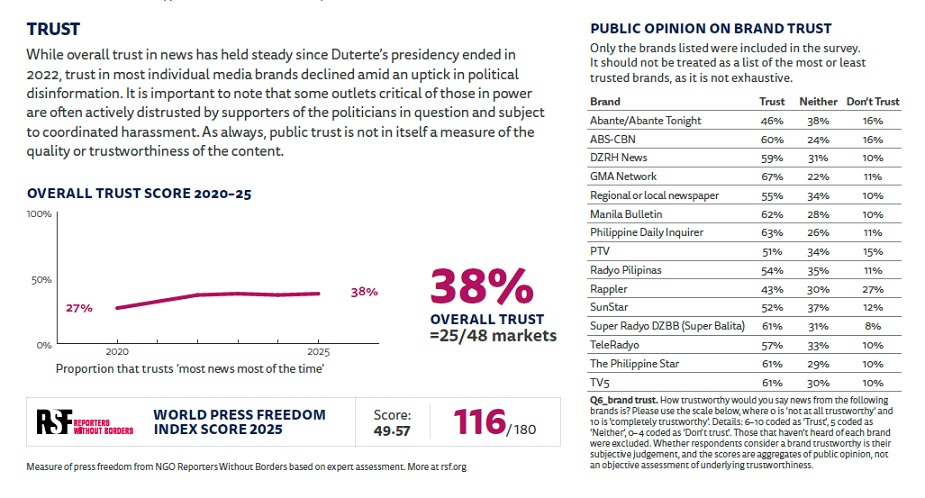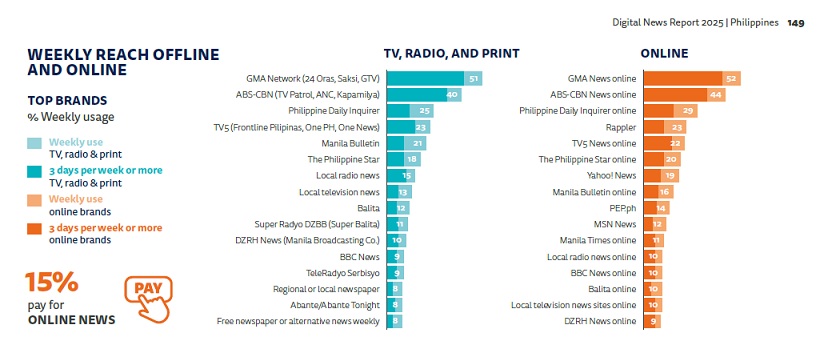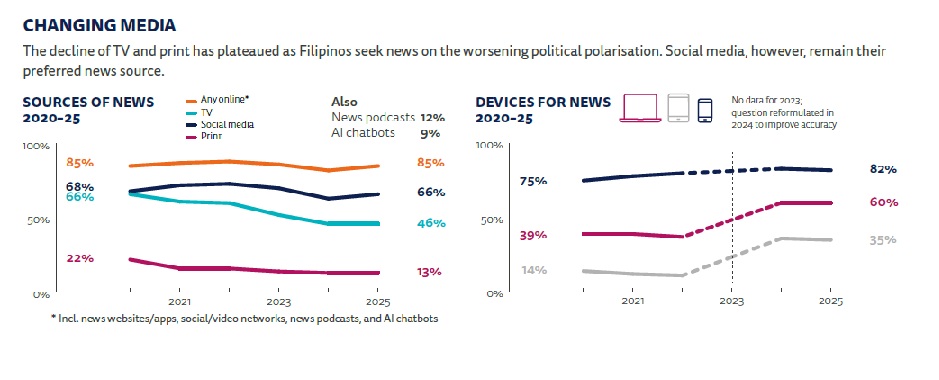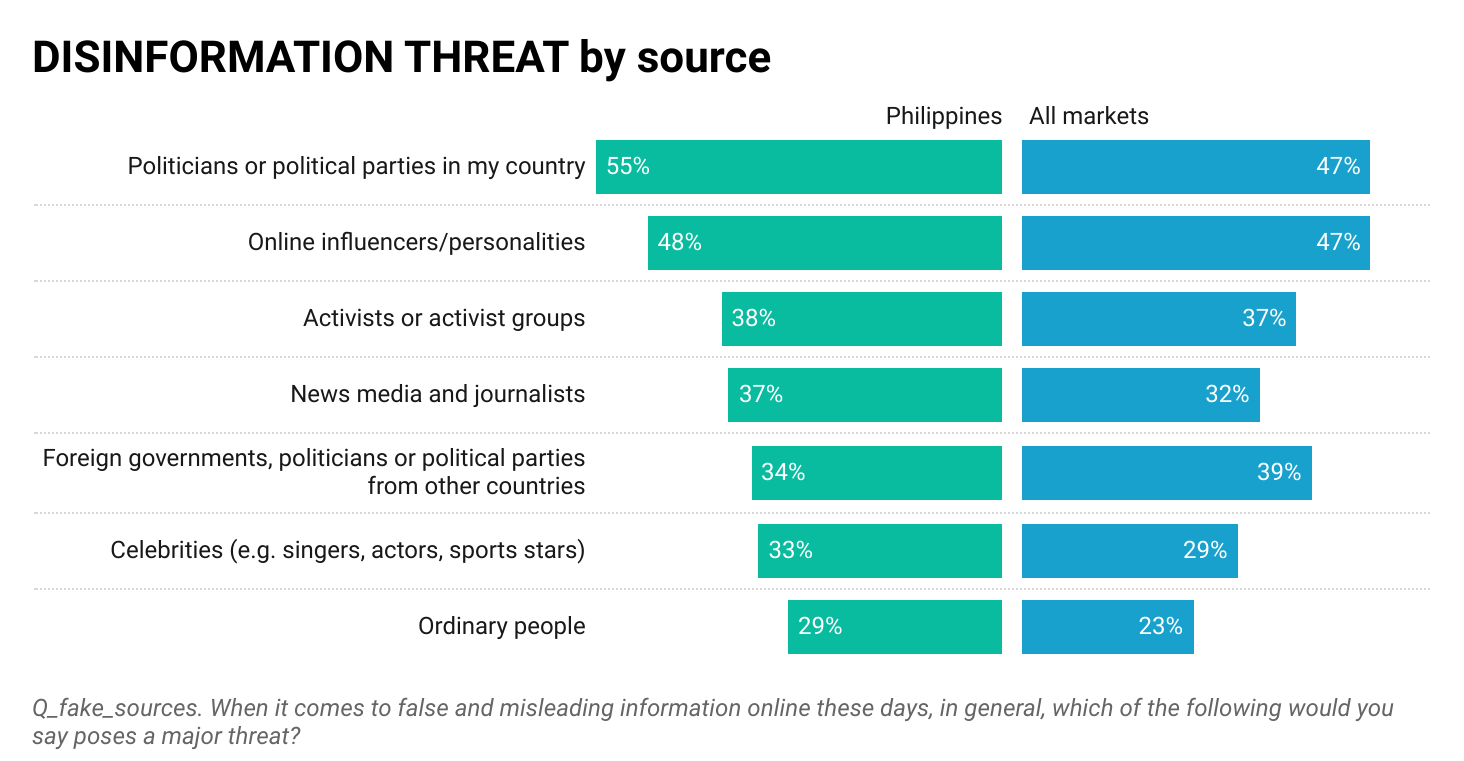Disinformation and harmful content surged in the Philippines over the past year – fuelled by the widening political rift between President Ferdinand Marcos Jr. and Vice President Sara Duterte. The fallout peaked with Duterte’s impeachment in February, followed a month later by the arrest of her father, former president Rodrigo Duterte, who faces charges of crimes against humanity before the International Criminal Court over his bloody war on drugs.
As the political crisis deepened, online platforms were flooded with false or misleading narratives and coordinated attacks targeting rival camps, activists, and journalists. This information disorder, often amplified by political influencers and partisan media, has continued to shape public perceptions of the press.
While our survey data show that overall trust in news improved after Rodrigo Duterte neared the end of his presidency in 2022 and has remained steady since, trust in nearly all media brands covered in this report slid over the past year amid intensified political disinformation, at least some of which is aimed at mainstream outlets for allegedly biased coverage.

In response to disinformation some newsrooms stepped up verification efforts and launched deeper investigations into influence operations. GMA Network, the country’s largest media organisation, launched Panata Kontra Fake News (Covenant Against Fake News), a multiplatform campaign in partnership with more than 50 newsrooms, academic institutions, and the Commission on Elections (Comelec). Five news organisations are now accredited by the International Fact-Checking Network, and the pioneering multisectoral fact-checking coalition Tsek.ph was relaunched for the May midterm elections.
These efforts aligned with Comelec’s initiatives to combat election-related falsehoods and the misuse of generative AI by candidates. These included partnerships with social media platforms and poll watchdogs as well as updated guidelines on campaign-related content. Meta’s support remains in question after it announced plans to stop using third-party fact-checkers on its platforms in the United States, though its programme in the Philippines continues for now.

A legislative inquiry by a tri-committee of the House of Representatives also sought to regulate digital platforms and counter online disinformation. Law enforcement has begun cracking down on vloggers accused of spreading falsehoods online.
YouTube disabled the accounts of Sonshine Media Network International (SMNI) in February 2025, followed by Facebook’s suspension in March, both citing violations of community standards. The hyper-partisan outlet is owned by
Apollo Quiboloy, a Duterte ally arrested in August 2024 on sexual misconduct charges. In December 2023, the government had suspended SMNI’s broadcast franchise following complaints of red-tagging – labelling individuals as communist or terrorist – and the spread of false information.
Amid this growing push to confront disinformation and AI risks, efforts to equip journalists with new tools also gained momentum. Newsrooms further experimented with generative AI. Rappler launched Rai, an in-house chatbot that guides users to verified information and election explainers. VERA Files deployed VERA, an AI-assisted fact-checking bot, on Facebook Messenger after piloting a tipline on Viber. The Philippine Center for Investigative Journalism turned one of its long-form reports into an AI-generated animated video to reach broader audiences.

The broadcast sector continued to restructure. NewsWatch Plus launched in July on RPTV, filling the void left by CNN Philippines with a mix of archived and digital-first content. In September, Bilyonaryo.com launched the Bilyonaryo News Channel on free and pay TV. MediaQuest sold its radio assets – including the prized 92.3 FM frequency – to Prime Media, a group linked to house speaker Martin Romualdez. It acquired 105.9 FM, rebranded it as True FM, and later launched the True TV channel.
GMA Network launched its first-ever news podcast, Philippines Today. According to this year’s Digital News Report survey, 12% of online Filipino adults now use podcasts to access news.
ABS-CBN, still without a franchise, announced in early 2025 the sale of a substantial portion of its Quezon City property. It also shut down its international segment, TFC News on TV Patrol, in January after trimming its domestic and North American workforce.

Print media showed further signs of strain. The Philippine Daily Inquirer, the country’s biggest newspaper, announced the integration of its print and digital operations effective from 1st July, a restructuring move expected to result in job losses for some in its print division. Months earlier, the Baguio Midland Courier, Northern Luzon’s oldest newspaper, ceased operations, citing soaring costs and shrinking readership. The paper’s closure marked a significant blow to local journalism.
Despite the many disruptions – and continuing physical, legal, and online attacks on journalists – one rare positive emerged. According to the Committee to Protect Journalists, no Filipino journalist was killed in the line of duty in 2024 – the first time this has occurred since democracy was restored in 1986, and its ranking in Reporters Without Borders’ World Press Freedom Index substantially improved. But that milestone was shattered in April 2025 when veteran journalist and publisher Juan Dayang was shot dead at his home.
